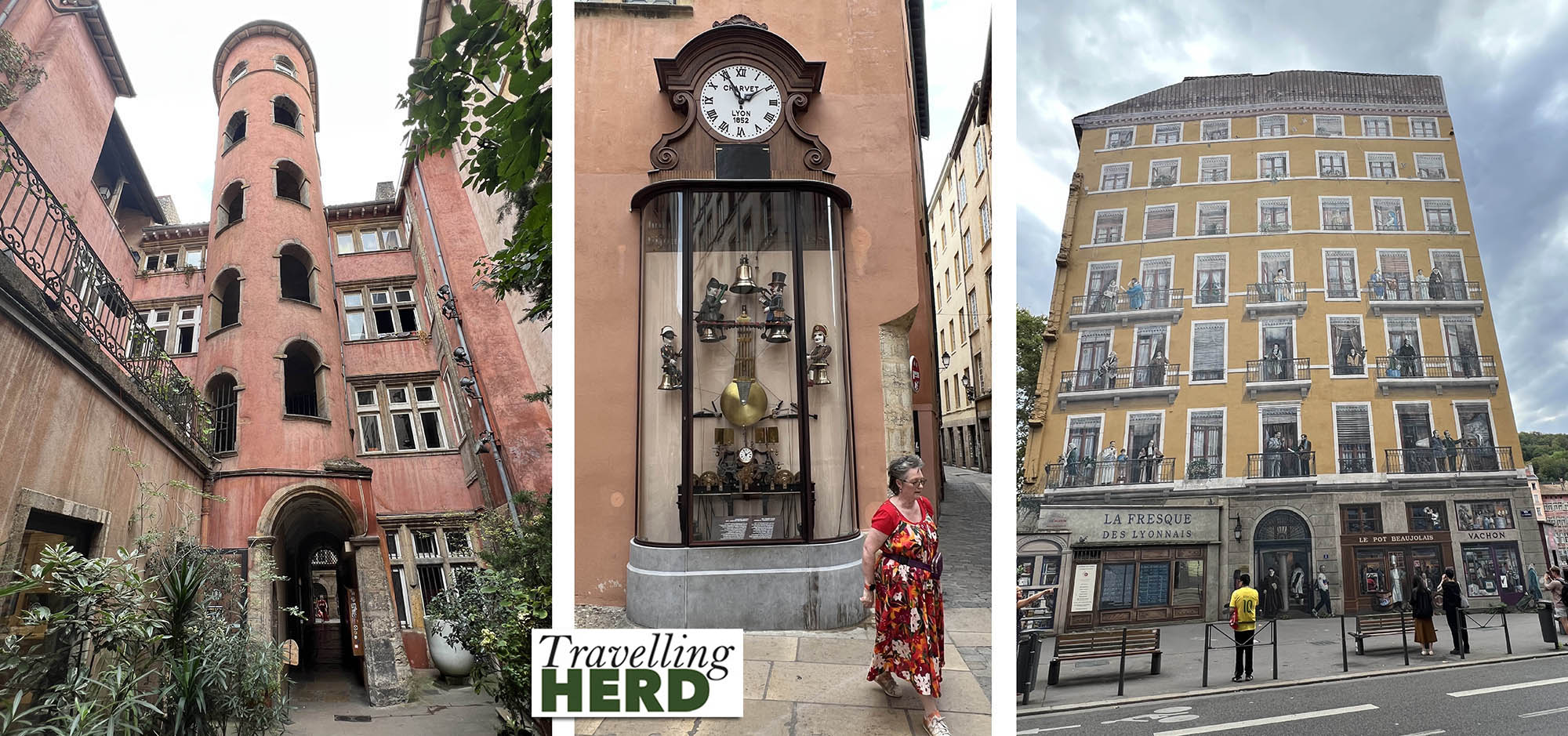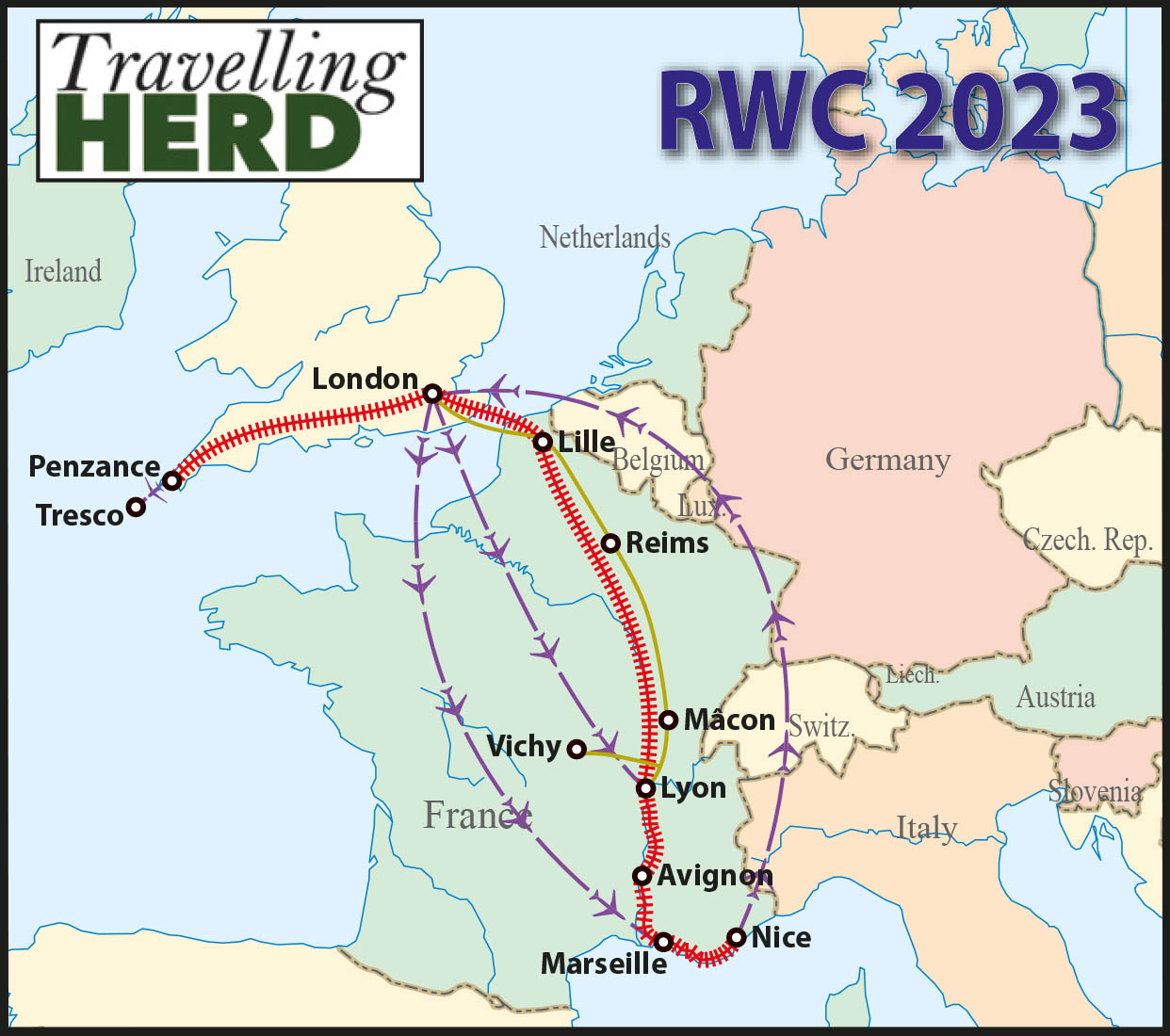Read this blog: The one where we slowly begin to remember
Monday 2nd to Thursday 5th October 2023
Having decided to postpone our visit to Dijon for another trip, Robert booked an extra night at the campsite in Lyon so that we could relax and have extended time in one place to see some sights and do our laundry. Sad but true. When we arrived we were told that the swimming pool would be closing that night for the season. Since it was sunny and hot, we felt we would stay on site and make use of the pool as it would be our only opportunity to do so. As we chilled in the pool we also planned to spread our culture and sightseeing over two half days.
Late the following morning we travelled into the centre to retrace our footsteps and reacquaint ourselves with the old city. Arriving on the metro at Vieux Lyon, we took the FI funicular [which was already waiting in the station] up to Minimes (Théâtres Romains) to see the amphitheatre. Robert said we had taken this route before although Matilda definitely recalls Robert making her walk up the hill in the heat last time we were here in 2016.
This would not be the only time our recollections differed.

We were delighted to be greeted by a poster advertising the Adventures of Brickius Maximus. On a family holiday to Italy in 2013, we took a Lego centurion mini figure with us and took photos of him in various iconic places including Pompeii. We named him Rory in honour of the ‘boy who waited’ in Dr Who and we felt, with hindsight, we should have brought him on this trip.

Lugdunum was the name of the Roman city where Lyon now stands and in Roman times it was the capital of Gaul. The Ancient Theatre of Fourvière, also referred to as the Amphitheatre of the Three Gauls, was built around 19AD under Emperor Tiberius when its main purpose was as an administrative centre for the Imperial province. Of course, it was also used for theatrical plays, gladiator fights and public executions.
Excavations of the amphitheatre were begun in earnest in 1956.

Fourviére is derived from the Latin name, ‘forum vetus’ meaning ‘old forum’.
When the amphitheatre was first built it was relatively small and could accommodate 1,800 spectators but two new galleries were added around 230AD increasing its capacity to 20,000. When we last visited sound checks were underway for a concert which is held regularly in the summer.

After the Roman era the site fell into disrepair and parts of the ruins were built over.
Indeed, the Basilica of Notre-Dame de Fourvière stands on the old forum built by Trajan. The church was built between 1872 and 1896 and dedicated to the Virgin Mary who is credited with saving Lyon from a multitude of misfortunes including the Plague in 1643; a cholera epidemic in 1832 and the Prussian invasion in 1871. The latter was the final catalyst which inspired the people of Lyon to build this tribute to the Virgin Mary. It combines Romanesque and Byzantine styles and the interior is adorned with beautiful turquoise and gold mosaics and vibrant stained glass.

The Basilica of Notre-Dame de Fourvière is perched above Lyon, much like the Sacré Coeur in Montmartre, with views across the city.

The Horloge aux Guignols in Place du Petit-Collège is a mechanical timepiece made by professional watchmaker, Louis Charvet in 1864. It plays a melody every quarter hour and on the hour a soldier springs to attention and strikes the chimes [see Video of the day]. Robert managed to time our arrival in the square for just a few minutes to two o’clock. Sometimes Matilda thinks he could find work as a tour manager or something similar.
From here we walked to see the Pink Tower [Tour Rose] and the Fresque des Lyonnais, a trompe l’œil which covers more than 800 square meters of a windowless building creating the illusion of an array of characters on their balconies.

Robert was delighted to find The Smoking Dog Pub open the second time we walked past on our way back from the fresco and even more pleased to discover that it served raspberry beer on draft.

On our last visit we had completely failed to discover the existence of the ‘traboules’ in the old town.
These are historic secret covered passageways, which meander through buildings, courtyards and up and down staircases.The majority are to be found in the old town in the Vieux Lyon and Croix Rousse areas. They were used by silk workers to keep their bolts of cloth dry from the rain as they transported them and by local residents to collect water from the river.
Individual ‘traboules’ are unique with their own pastel colour and characterised by a particular curve or spiral staircase, vaulted ceilings or Renaissance arches. Robert found a sign next to a green door and we cautiously opened it, feeling as though we were trespassing, then walked through a private hidden world.
And in a way we were.
The traboules are privately owned but the ‘Courtyard and Traboule Agreement’of 1990 states that the City will contribute to the costs of maintaining, cleaning and lighting these areas, in exchange for a public pedestrian right of way through the traboules and private courtyards, between 07:00 and 19:00, every day of the year. Owners also accept that there will be information plaques at the entrances to courtyards and traboules, and a sign asking visitors to respect these spaces.
We visited one but later found out that many more are open to the public, each clearly marked with a small identifying seal and next time we visit we will seek out more of these ancient pathways.
During the WWII, the traboules were used by the resistance for secret meetings, thus preventing the Nazis from occupying the whole of Lyon.

We walked down Rue saint-Jean and Robert recognised a hostelry we had visited in 2016. Matilda on the other hand recalled eating ice cream here but it seems that ice cream parlour may have closed down. Looking back through photographs on his phone, Robert found the evidence and felt he needed to recreate a moment from our last visit in 2016. The waitress kindly obliged.

The following morning we rose late and went to do our laundry so that we could hang it out to dry before heading back into Lyon.

This time our sightseeing walk took us past the Opéra Nouvel, an 1831 theatre that was modernised in 1993. The renovations left only the existing foyer and the exterior façade. The interior space was tripled by excavating to create rehearsal space and by adding a steel and glass barrel vault which doubled the height of the building whilst also hiding the rigging system. It is indeed a fusion of traditional and modern architecture.

The most famous fountain in Lyon is the Bartholdi Fountain in the Place des Terreaux. Designed in 1889 it was originally intended for Bordeaux but the town deemed it to be too expensive and it was eventually erected in Lyon in 1892. Bartholdi is perhaps more famous for the Statue of Liberty in New York.

Opposite the Opéra Nouvel stands the imposing Hôtel de Ville [Town Hall].

Even more impressive is the Hôtel Dieu on the banks of the Rhône. This was first built in the 12th century, at the same time as the first bridge across the Rhône, allowing the city to welcome pilgrims and travellers arriving from the east. The building has interesting links with several historical figures. Matilda was interested to learn that François Rabelais was appointed to work at the Hôtel Dieu as a doctor in 1532 and while here he wrote the picaresque novel Gargantua and Pantagruel which she studied at university. The building was extended significantly under Louis X111 and Cardinal Richelieu and again under Louis XIV.
It has been out of use as a hospital since 2010 but has been repurposed as a high end shopping area. Matilda felt overwhelmed by the sheer size of the space and felt she would never have been able to find her way round it to visit someone in hospital. The multiple courtyards now provide a spacious and calm space for refreshments but Matilda was not allowed to indulge.

The Court of Appeal or Palais de Justice in Lyon is a large neoclassical courthouse built in the 1840s with 24 columns across its facade which is more than enough to intimidate any appellant.

Nearby stands a statue entitled The Weight of One Self created by Norwegian sculptors Michael Elmgreen and Ingar Dragset. It is a striking sculpture open to interpretation as the figures have the same face.

From here we headed back into old Lyon for some lunch [see Dish of the day] then out to the OL Stadium for the New Zealand vs Uruguay match. Unfortunately we did not manage to synchronise a meeting with Gill and Paul this time but Matilda was amused to see that self service beer had been installed in the Au Fût bar since our last visit.

The stadium reflected the setting sun as we entered but although it is a pleasure to watch New Zealand play rugby well, it is hard to see them against a team so mismatched and we British do like to support the underdog.

Video of the day:
Selfie of the day:

Dish of the day:

Route Map:






